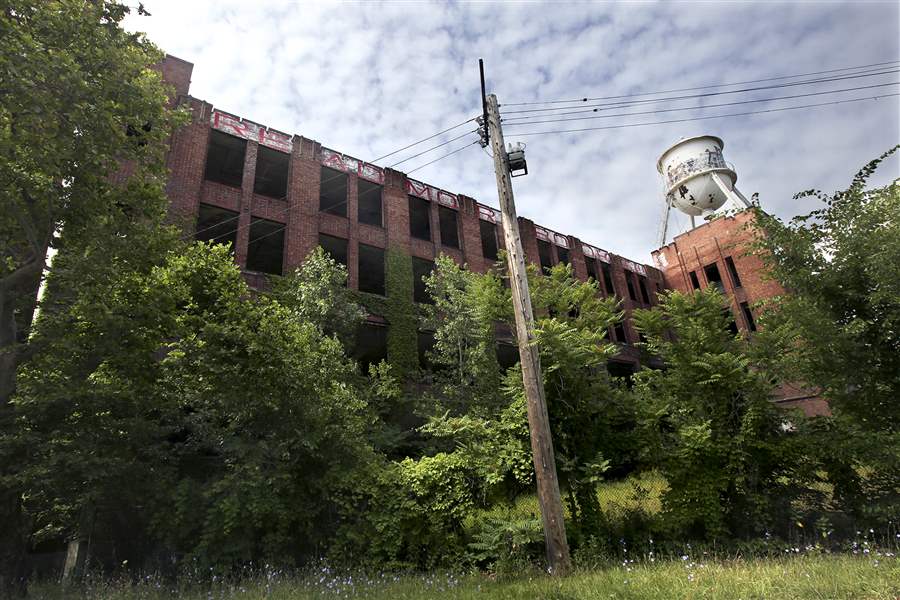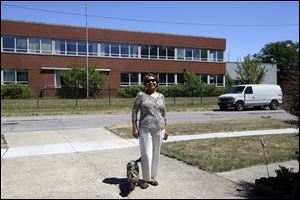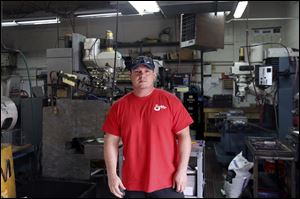
BLADE SPECIAL REPORT
Tough talk on trade finds Cleveland eager to listen
Convention host reeling from poverty, plant closings
7/3/2016
The shuttered and overgrown Joseph & Feiss textile factory looms over the surrounding residential neighborhood on Cleveland’s near west side. Since 1960, Cleveland has lost dozens of factories, according to a list compiled by The Blade.
THE BLADE/KATIE RAUSCH
Buy This Image

Dina Camacho says her neighborhood went downhill when the TRW factory behind her closed. ‘They had people who came from Pennsylvania to work here. When they closed, they sold their houses and went back to their places.’ Two businesses now occupy portions of the plant. Mrs. Camacho supports Hillary Clinton. ‘She has a lot of experience,’ she says.
CLEVELAND — Donald Trump couldn’t have picked a better location than Cleveland to kick off a campaign aimed at a population depressed and frustrated by the loss of manufacturing might.
Since 1960, Cleveland has lost dozens of factories, according to a list compiled by The Blade from available public records, news reports, and interviews with academics and the Cleveland Federal Reserve.
And while some of those factories have been replaced by new manufacturing plants, the total number of people employed in metro Cleveland manufacturing has declined by nearly 50 percent in the last 26 years.
MAP IN DETAIL: Cleveland hard hit by factory closings since 1960
PHOTO GALLERY: Fall of manufacturing in Cleveland
It’s a city still reeling from the combined impacts of automation and globalization, as seen by a poverty rate that made it the second-most impoverished city of more than 250,000 people in the U.S. Census’s most recent estimates in 2015.
Many people blame the international trade agreements that have made it harder for American manufacturers, burdened with labor, environmental, tax, and regulatory requirements that don’t apply in Mexico or China, to compete.
Ironically, it’s the Republican Party’s presumptive nominee for president, Donald Trump, who is making that claim most forcefully.
In televised debates last fall and throughout the winter and spring primary and caucus campaigns, Mr. Trump has hammered at “stupid” trade policies.
Not one to pick his words delicately, Mr. Trump said, “the dumbest people in the world are making the worst trade deals.”
Mr. Trump has won enough delegates in the national primaries and caucuses to win the Republican nomination on the first ballot when Republican delegates assemble July 18-21 at the Quicken Loans Arena in Cleveland for the presidential nominating convention.
A self-described billionaire who has made his wealth mainly in real estate but also has dabbled in selling eponymous-brand products, Mr. Trump has struck political pay dirt with his criticism of America’s trade policy. It’s a stance that conflicts directly with Republican doctrine, that free global trade is in America’s best interest.
Mr. Trump has made a pillar of his campaign — especially in the industrial Midwest — that America is being outmaneuvered on trade by Mexico and China.
He has proposed slapping a 45 percent tariff on Chinese goods entering the country, vowed to slap a 35 percent tariff on Ford trucks and Carrier air conditioners if new factories for those products are built in Mexico, and vowed to renegotiate NAFTA, the North American Free Trade Agreement signed by President Bill Clinton.

Trump
“Our politicians took away from the people their means of making a living and supporting their families. Skilled craftsmen and tradespeople and factory workers have seen the jobs they love shipped thousands and thousands of miles away,” Mr. Trump said in a speech in Monessen, Pa., Tuesday.
“For years, they watched on the sidelines as our jobs vanished and our communities were plunged into Depression-level unemployment. Many of these areas have never recovered and never will unless I become president. Then, they’re going to recover fast,” Mr. Trump said.
Democratic candidate Hillary Clinton also has come to be critical of NAFTA after many years of supporting the agreement that knocked down trade barriers between the United States, Mexico, and Canada. As a U.S. senator from New York she voted in 2005 against the Central America Free Trade Agreement, and now opposes the proposed Trans-Pacific Partnership trade agreement negotiated by President Obama, though she supported it as his secretary of state.
Progressives and organized labor are critical of NAFTA because they believe it allowed American businesses to move manufacturing to cheaper labor supplies in Mexico and then sell their products at a higher profit back in the United States, while their formerly well-paid union workers struggled to get by on lower wages, or with no jobs.
Democrats, including President Obama, attacked Mr. Trump’s rhetoric as protectionist. Mrs. Clinton has rolled out a more nuanced position on trade, promising to be tough on trading partners.
Hope Hicks, Mr. Trump’s spokesman, said, “America has lost nearly one-third of its manufacturing jobs following the adoption of Hillary Clinton-backed trade deals like NAFTA and China’s entrance into the [World Trade Organization]. If she gets the chance, she will put us into the [Trans-Pacific Partnership]. Mr. Trump will defend every last manufacturing job in Ohio from unfair trade and enforce every last trade rule to protect our jobs, security, and economic independence.’’
According to her campaign, Mrs. Clinton would seek to tap new world markets for Ohio products. She also would make areas like Cleveland that have lost manufacturing jobs and plants eligible for investment tax incentives to attract new capital and business.
“Donald Trump does not have a plan to strengthen American manufacturing, a pretty significant omission, but perhaps not surprising because he doesn’t really have a record of manufacturing his products in America either,” said Laura Zapata, a Clinton spokesman.
The Republican Party could never have envisioned Cleveland being the poster child for a Republican protectionist-based campaign by its own candidate when the Republican National Committee selected Cleveland as the site of its convention in 2014.
It opens the possibility that metro Cleveland, while it has a solid history of voting Democratic, could prove to be open to a Trump-like appeal in the same way that blue-collar counties ringing Detroit proved amenable to the conservative message of Ronald Reagan in 1980, which gave rise to the term “Reagan Democrats.”
While Cleveland puts up a good front, its years as a manufacturing powerhouse are fading. The result is a landscape dotted with vacant and underutilized industrial buildings.
For all the glitz of its recent NBA championship, the Rock and Roll Hall of Fame, and the islands of charming neighborhoods that once struggled to stay safe and now host trendy restaurants where a grilled cheese sandwich costs $13, Cleveland still stands out as one of America’s poorest cities.

Jeff Yates, plant manager at Richard’s Grinding Inc. in Cleveland, says his industry has taken a real hit as manufacturing in the region has declined. He says he’s suspicious of politicians’ promises but admits he’s ‘fired up’ by what he hears from Donald Trump. His boss, Debbie Luber, below, says that while some of Mr. Trump’s ideas — like a 45 percent tariff on Chinese steel — appeal to her, she’s not won over. ‘He does scare me,’ she says of Mr. Trump.
As recently as 2015, the census said Cleveland was America’s second-poorest large city, eclipsed only by Detroit.
And the employment rate that bottomed out in the Great Recession appears to be rising again.
Precise manufacturing employment numbers are hard to come by for the city of Cleveland. The metro area, defined by the U.S. Bureau of Labor Statistics to include Cuyahoga, Lake, Medina, Lorain, and Geauga counties, shows a steady drop in manufacturing employment from 1990 until 2009.
The bureau’s records show 213,500 manufacturing jobs in metro Cleveland in July, 1990. That number declined to a low of 114,000 manufacturing jobs by 2009. Employment rebounded to 125,000 as of July, 2015, but has started falling again. In May, Cleveland showed 119,800 manufacturing jobs, the worst manufacturing employment number in May since 2010.
Factories’ fall
The sleepy little neighborhood of Walworth Run on Cleveland’s near west side wasn’t always so sleepy.
Quiet frame houses bask in summer sunshine or the shade of tall trees. Few cars disturb the rural ambiance of this neighborhood just blocks away from busy I-90.
The biggest edifice is an old brick factory building with all of its windows blasted out, and with the boarded-up entry partially removed and easily accessible to any adventurer.
It was once the home of Joseph & Feiss, maker of fine menswear. Published reports say the business once employed 2,000. While many other American textile makers had closed their doors, Joseph & Feiss hung on until 1998.
A sign says the warehouse building is to be repurposed as a charter school.
“It was full of people and three shifts and it was constantly busy. There was always something going on,” said Debbie Luber, owner of Richard’s Grinding Inc., a small custom machine shop across Walworth Avenue from the overgrown and badly tended former Joseph & Feiss site.
Joseph & Feiss was acquired by Hugo Boss garment manufacturer, and its work was relocated to Brooklyn, Ohio, which is also in Cuyahoga County. After that, Hugo Boss was acquired by W Diamond Group Corp., which still has 160 workers making high-end men’s suits.
Richard’s Grinding itself is a factory, though a small one, with 11 employees. The business once sharpened “mill ends” by the thousands — steel cutting bits used to shape steel in Cleveland’s many heavy industries. Those mill ends are now manufactured offshore and discarded when they wear out. Now Richards finds work doing custom machining.
Mrs. Luber’s father started the business, and she has worked there for 30 years. At one time, Richards had up to 16 employees.
Mrs. Luber likes Mr. Trump’s idea of a 45 percent tariff on Chinese competition, but she’s not been won over to Mr. Trump.
“He does scare me,” she said.
Plant manager Jeff Yates harbors suspicion of politicians’ promises, but admits he’s “fired up” by what he hears from Mr. Trump. “I like what he’s saying,” Mr. Yates said.

Frances Powell, left, and her son Kincaid, 8, pause as they walk home from the day care center where Ms. Powell works. The daily walk in the city’s Mount Pleasant neighborhood takes them past a shuttered SR Products plant where a guard warns of hazardous materials.
Going downhill
At the northeast edge of Cleveland, Dina Camacho’s eyes fill with tears when she thinks of the break-ins at her lovingly-tended home on East 185th Street.
The neighborhood has gone downhill since TRW shut down its factory across the street in 2002.
TRW, based in Livonia, Mich., made engine valves, though it has a different mission today. Squeezed by the highly competitive international automotive market of the 1980s and 1990s, TRW closed the engine plant in 2002, laying off its remaining 500 workers.
Two businesses occupy part of the plant and use a portion of the parking lot.
“This was nice, nice, nice,” she said of the big factory, which the city of Cleveland has been trying to market. “A lot of people. They had people who came from Pennsylvania to work here. When they closed, they sold their houses and went back to their places.
“They used to make parties for the neighborhood in the summer. Everybody was happy,” said Mrs. Camacho, a transplant from Lima, Peru.
Now her house is valued at $18,000 and she can’t afford to move to Eastlake, Ohio, as she’d like.
“They broke into my house, two, three times,” Mrs. Camacho, 75, said, becoming emotional. Mrs. Camacho said she’s with Mrs. Clinton.
“She has a lot of experience. Nobody is better than her,” she said.
Reasons for decline

Arguably the biggest industrial site in Cleveland is the ArcelorMittal steel mill in Cuyahoga Valley. The Cleveland Works once employed 4,000, but now has just more than 1,400 workers. It’s been known as Jones & Laughlin, Republic Steel, and LTV. A 2001 layoff when it was LTV and announced under the Worker Adjustment and Retraining Notification Act affected 2,964 workers
What used to be the legendary J&L plant is now a modern shopping center, Steelyard Commons, and anchors the Tremont neighborhood, a fast-reviving community with niche restaurants such as Lucky’s Cafe, which specializes in locally grown ingredients.
Pat Gallagher, the director of the northern Ohio district of the United Steel Workers’ union, said there were once nine blast furnaces in Cleveland. There are two today.
He says the ArcelorMittal mill is “the most productive, man-hour-per-ton, integrated mill in the world.”
Though Mr. Trump’s message of sticking a 45 percent tariff on Chinese steel on its surface might be an attractive one to someone in Mr. Gallagher’s situation, he’s not buying it.
“Trump’s also said American workers make too much money, so he’s talking out of both sides of his mouth,” Mr. Gallagher said.
He said that what America needs is an industrial policy, one that makes manufacturing a priority to the nation, the way China does.
“People aren’t happy. We’ve lost something like 60,000 jobs since 2000 and it’s all due to these international trade deals. The U.S. doesn’t have an industrial policy,” he said. “China builds whole cities to support their factories. They make a conscious decision.
“The economy is not a force of nature. We’re not making the right decisions,” Mr. Gallagher said.
Ohio State University economics professor Ned Hill said blaming Ohio’s manufacturing decline on international trade agreements is simplistic.
“NAFTA’s pretty complicated, and it’s been shown to be absolutely ripe for demagoguery, and people just assume that every manufacturing job that’s left the state since the 1970s went to Mexico or somewhere else and it just isn’t true,” Mr. Hill said.
He said the biggest factor in the loss of manufacturing was the application of automation. Another reason is that the markets for which Cleveland’s factories were built changed. It’s the same story for factories in the rest of the Rust Belt.
“These factories were perfectly attuned to satisfy the market demands of the 1940s. We didn’t adjust for a couple of reasons, the first thing was the new products were being invented elsewhere. Secondly, people thought they had lifetime employment and frankly the flexibility of the work force wasn’t there,” Mr. Hill said.
Still, it’s obvious that Mexico and China — two countries with dramatically cheaper manufacturing environments — sucked manufacturing capacity out of the old industrial Midwest.
According to the liberal-leaning Economic Policy Institute, by 2010, 34,900 jobs had been lost or displaced in Ohio — and about 700,000 in the United States — because of the rise in the trade deficit with Mexico since NAFTA was enacted in 1994. The Economic Policy Institute also found that by 2013, 106,400 jobs had been lost or displaced in Ohio — and more than 3.2 million in the United States — because of the rise in the trade deficit with China since it joined the World Trade Organization in 2001.
Toxic remains
In Cleveland’s gritty Mount Pleasant neighborhood, at Union Avenue and 133rd Street, a well-armed security guard wearing a sidearm warns the curious away from the former SR Products building at 13311 Union Ave.
The building looks innocent enough, with its empty parking lot, closed doors, and weed-entwined chain link fence, but the guard warns it contains toxic contamination that is more dangerous than the vicious dog advertised on the sign.
SR Products makes roofing materials. It didn’t move to China or Mexico. Its website says, “SR Products has a state-of-the-art manufacturing facility located in Struthers, Ohio,” Mahoning County, and shows pictures of a beautiful, modern factory.
Frances Powell, 47, a lifelong resident of the neighborhood, walks her son, 8-year-old Kincaid, home from day care past the vacated building. She remembers when “you’d always see trucks in the bay.”
“It was much better than it is now,” Ms. Powell said.
Staff Writer Michelle Liu contributed to this report.
Contact Tom Troy: tomtroy@theblade.com or 419-724-6058 or on Twitter @TomFTroy.